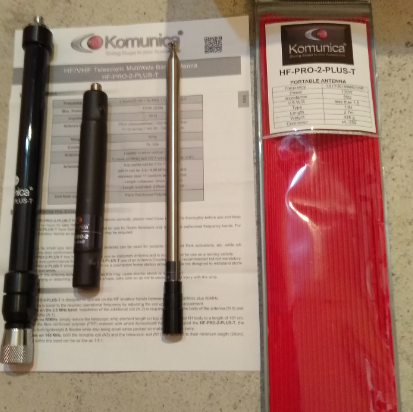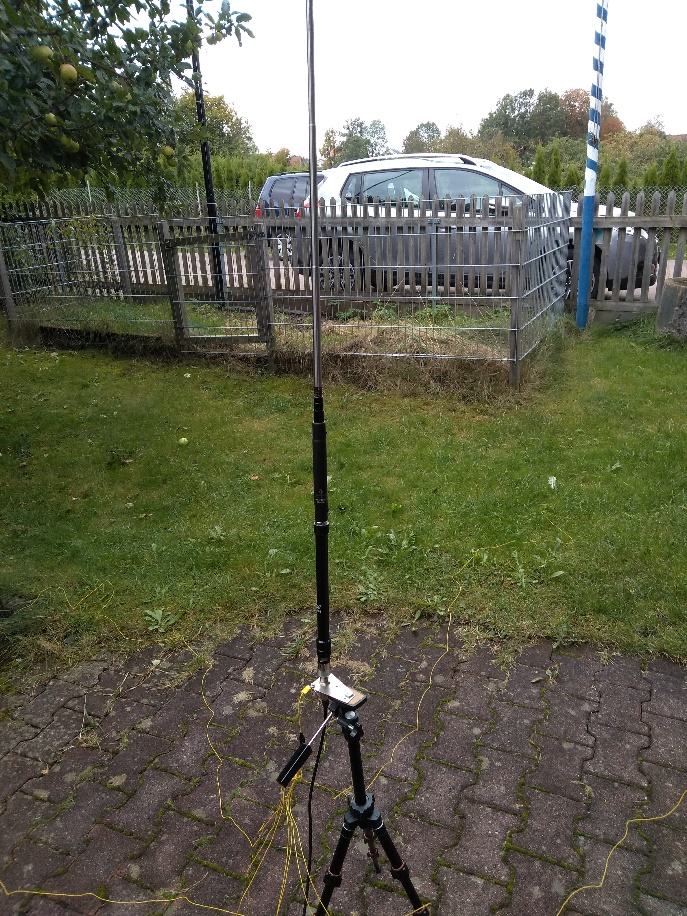A New antenna under review–the Komunica Power HF-PRO-2-PLUS-T
It is a constant search in amateur radio to find the “best” antenna.
But what does “BEST” really mean.
Yes, it could mean the highest gain, lowest noise antenna and for that the amateur spends thousands of dollars on a tall tower and enormous beam antenna or multiple phased beams.
But what about the rest of us that don’t have either the land or the money to set up such a great antenna. “BEST” to us means the best we can manage within our budget.
What if we are in a home location where there’s no chance to put up a HF antenna at all and we have to go out portable – or we prefer to operate portable, from a park, from a summit or from an island. Now other things come into consideration, such as size and weight and if operating alone, can the antenna be put up by one person? If it is an antenna using a mast, how will the mast be supported? Is there enough room for guy ropes? If we want to keep things really light – we just want to throw a wire in a tree – what if there are no trees or the park warden doesn’t allow that?
The “Best” antenna depends upon the situation and if we are talking portable operation going somewhere we haven’t been before, we have to have an adaptive answer that doesn’t rely on a fence post or trees to be available to support a mast or wire antenna.
At best the antenna should work on more than one band as we never know how radio conditions will be and switching bands may make the difference between making contacts and not.
Talking of conditions, weather can change quickly when you are miles from anywhere in the countryside or up a mountain, so an antenna that can be taken down and packed away quickly would be a good idea.
So, lets define our needs for a portable antenna,
- Small to carry,
- Light,
- Self-supporting,
- Multi-band without needing an ATU,
- Reasonably priced,
- Quick to put up and take down.
If you ask 5 portable operators, you will get at least 7 different answers between them – but does any one answer fulfil all of our needs?
Here’s a brand new one that does – the Komunica HF-PRO-2-PLUS-T HF & VHF loaded vertical which I have purchased based on my good experiences with its predecessor. This is my review and my experiences – as always YMMV.
Some of you may have heard of the basic HF-PRO-2 model which I have used for a couple of years. This new “-PLUS-T” model has the solid radiating element replaced with a telescopic one. This improves on our points 1 & 6.
The antenna itself is designed to fit an SO-239 socket and so can be used “static-mobile” on a magnetic mount on top of a car, if that’s the way you go portable or it can be used with a small tripod and radial wires – which is also available from Komunica or you can do as I did and took an unused photographic tripod and converted it by adding an SO239 socket and 8 3 metre long radial wires. (adapting your own tripod of course helps our aim number 5.).
Another difference with this new model over the basic HF-PRO-2 is that the parts are simply screwed together by hand rather than using an Allen key – this fact alone will pay for itself when out on a mountain top in driving snow with gloves on – trying to find a dropped Allen key in the snow is not fun!
The HF-Pro-2 covers 40m – 10m plus 6m.
The HF-PRO-2-PLUS-T is sold as covering 80m & 40m through 10m plus 6m and 2m. In fact, it will also cover 8m (40-44MHz) and 4m (70-71 MHz) as well. It gains coverage of 80m and to some extent 60m by using an add-in coil, that again is screwed into the antenna by hand. The bands above 30MHz are obtained by adjusting the length of the telescopic antenna element.
The amazing thing about this antenna is how small the components are when taken apart. You can lay the main loading coil body, the 80m coil and the telescopic element along side each other easily on a piece of A4 paper.

When assembled and extended though – as you can see, there is very little difference in size between the HF-PRO-2 and the “PLUS-T”:

The Komunica HF-PRO-2 is on the left in all of these three pictures. The PLUS-T on the right.
Which of these sets will fit inside your small backpack??
While the HF-PRO-2-PLUS-T covers VHF as well as HF. The use on VHF (8m, 6m, 4m & 2m) is purely by using the telescopic sections adjusted to be a ¼ λ (8 metres and 6 metres) or a 5/8 λ (4 metres and 2 metres) whip and you can expect an SWR between 2 and 2.5:1. Still usable and it does avoid taking another antenna to the summit for these bands but the antenna’s primary bands are the HF ones where an SWR around 1.5:1 can be expected. The exception to this is 60 metres where again an SWR over 2:1 can be expected. To be fair to Komunica, they do not sell this antenna as a 60-metre antenna, rather a 40 metre to 10 metre one with 80 metres supported by adding the extra loading coil. With 60 metres, it’s a case of, if you don’t have a better 60 metre antenna with you and you need to operate on the band, this antenna will work.
Generally, for its small assembled size, the antenna performs well, making contacts around continental Europe (east & west), and into the UK and Scandinavia. Reception of stations from the US and Australasia is possible on 40m at present (October 2020) but so far, I haven’t made contacts with these DX locations using this antenna. Perhaps as conditions improve as we move into solar cycle 25 and 20, 17 & 15m open up again, such contacts will be possible.
To meet all of our listed requirements for a portable antenna, there has to be compromises and only you will know whether the performance of this antenna is good enough for you or whether you prefer to have the better performance of a full-sized single band or linked dipole and are happy to carry the needed support mast. One thing is for sure, this antenna is small enough to have inside your backpack with a small tripod and radial wires teamed up with one of the small portable rigs with their internal battery like the Yaesu FT-818, Elecraft KX-2 or ICOM IC-705 and you have a portable solution with you “just-in-case” you have time, or need it unexpectedly that will perform well.
Is this the “BEST” portable antenna solution? As always it depends on your personal needs but for me, for weight, size, price and performance, it’s the best I know of at the moment.

73 & work you on the bands! Ed DD5LP.
Antenna in use:
- On car (using magnetic roof mount):

- Testing and recording settings on tripod in garden:



No comments:
Post a Comment